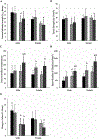Hindlimb Skeletal Muscle Function and Skeletal Quality and Strength in +/G610C Mice With and Without Weight-Bearing Exercise
- PMID: 25829218
- PMCID: PMC8157311
- DOI: 10.1002/jbmr.2518
Hindlimb Skeletal Muscle Function and Skeletal Quality and Strength in +/G610C Mice With and Without Weight-Bearing Exercise
Abstract
Osteogenesis imperfecta (OI) is a heterogeneous heritable connective tissue disorder associated with reduced bone mineral density and skeletal fragility. Bone is inherently mechanosensitive, with bone strength being proportional to muscle mass and strength. Physically active healthy children accrue more bone than inactive children. Children with type I OI exhibit decreased exercise capacity and muscle strength compared with healthy peers. It is unknown whether this muscle weakness reflects decreased physical activity or a muscle pathology. In this study, we used heterozygous G610C OI model mice (+/G610C), which model both the genotype and phenotype of a large Amish OI kindred, to evaluate hindlimb muscle function and physical activity levels before evaluating the ability of +/G610C mice to undergo a treadmill exercise regimen. We found +/G610C mice hindlimb muscles do not exhibit compromised muscle function, and their activity levels were not reduced relative to wild-type mice. The +/G610C mice were also able to complete an 8-week treadmill regimen. Biomechanical integrity of control and exercised wild-type and +/G610C femora were analyzed by torsional loading to failure. The greatest skeletal gains in response to exercise were observed in stiffness and the shear modulus of elasticity with alterations in collagen content. Analysis of tibial cortical bone by Raman spectroscopy demonstrated similar crystallinity and mineral/matrix ratios regardless of sex, exercise, and genotype. Together, these findings demonstrate +/G610C OI mice have equivalent muscle function, activity levels, and ability to complete a weight-bearing exercise regimen as wild-type mice. The +/G610C mice exhibited increased femoral stiffness and decreased hydroxyproline with exercise, whereas other biomechanical parameters remain unaffected, suggesting a more rigorous exercise regimen or another exercise modality may be required to improve bone quality of OI mice.
Keywords: BONE; COLLAGEN CROSS-LINKS; EXERCISE; MUSCLE; OSTEOGENESIS IMPERFECTA.
© 2015 American Society for Bone and Mineral Research.
Conflict of interest statement
Disclosures
All authors state that they have no conflicts of interest.
Figures







Similar articles
-
Morphological and mechanical characterization of bone phenotypes in the Amish G610C murine model of osteogenesis imperfecta.PLoS One. 2021 Aug 27;16(8):e0255315. doi: 10.1371/journal.pone.0255315. eCollection 2021. PLoS One. 2021. PMID: 34449800 Free PMC article.
-
Combinatorial Inhibition of Myostatin and Activin A Improves Femoral Bone Properties in the G610C Mouse Model of Osteogenesis Imperfecta.J Bone Miner Res. 2022 May;37(5):938-953. doi: 10.1002/jbmr.4529. Epub 2022 Mar 9. J Bone Miner Res. 2022. PMID: 35195284 Free PMC article.
-
Impact of Genetic and Pharmacologic Inhibition of Myostatin in a Murine Model of Osteogenesis Imperfecta.J Bone Miner Res. 2021 Apr;36(4):739-756. doi: 10.1002/jbmr.4223. Epub 2020 Dec 18. J Bone Miner Res. 2021. PMID: 33249643 Free PMC article.
-
Extra-Skeletal Manifestations in Osteogenesis Imperfecta Mouse Models.Calcif Tissue Int. 2024 Dec;115(6):847-862. doi: 10.1007/s00223-024-01213-4. Epub 2024 Apr 19. Calcif Tissue Int. 2024. PMID: 38641703 Review.
-
Impact of Intrinsic Muscle Weakness on Muscle-Bone Crosstalk in Osteogenesis Imperfecta.Int J Mol Sci. 2021 May 7;22(9):4963. doi: 10.3390/ijms22094963. Int J Mol Sci. 2021. PMID: 34066978 Free PMC article. Review.
Cited by
-
Makings of a brittle bone: Unexpected lessons from a low protein diet study of a mouse OI model.Matrix Biol. 2016 May-Jul;52-54:29-42. doi: 10.1016/j.matbio.2016.03.005. Epub 2016 Mar 31. Matrix Biol. 2016. PMID: 27039252 Free PMC article.
-
Osteogenesis imperfecta: an update on clinical features and therapies.Eur J Endocrinol. 2020 Oct;183(4):R95-R106. doi: 10.1530/EJE-20-0299. Eur J Endocrinol. 2020. PMID: 32621590 Free PMC article. Review.
-
Bone mineral properties in growing Col1a2(+/G610C) mice, an animal model of osteogenesis imperfecta.Bone. 2016 Jun;87:120-9. doi: 10.1016/j.bone.2016.04.011. Epub 2016 Apr 13. Bone. 2016. PMID: 27083399 Free PMC article.
-
Soluble activin receptor type IIB decoy receptor differentially impacts murine osteogenesis imperfecta muscle function.Muscle Nerve. 2018 Feb;57(2):294-304. doi: 10.1002/mus.25706. Epub 2017 Jun 15. Muscle Nerve. 2018. PMID: 28555931 Free PMC article.
-
Muscle abnormalities in osteogenesis imperfecta.J Musculoskelet Neuronal Interact. 2017 Jun 1;17(2):1-7. J Musculoskelet Neuronal Interact. 2017. PMID: 28574406 Free PMC article. Review.
References
-
- McKay HA, Bailey DA, Wilkinson AA, Houston CS. Familial comparison of bone mineral density at the proximal femur and lumbar spine. Bone Miner. 1994;24(2):95–107. - PubMed
-
- Turner CH. Bone strength: current concepts. Ann NY Acad Sci. 2006;1068:429–46. - PubMed
-
- Skerry TM. One mechanostat or many? Modifications of the site-specific response of bone to mechanical loading by nature and nurture. J Musculoskelet Neuronal Interact. 2006;6(2):122–7. - PubMed
Publication types
MeSH terms
Substances
Grants and funding
LinkOut - more resources
Full Text Sources
Medical

